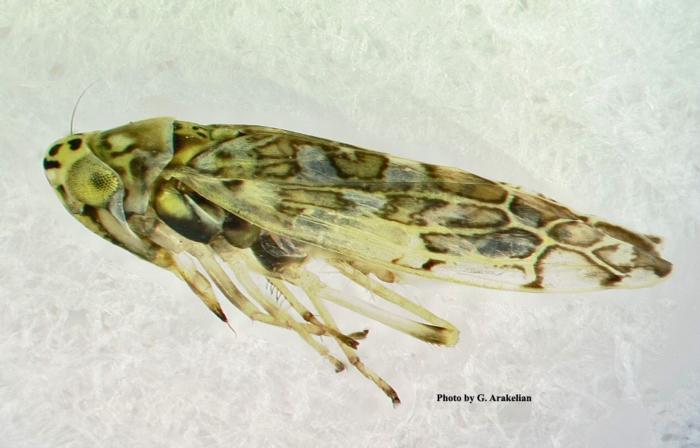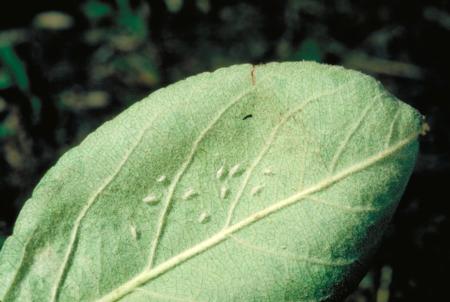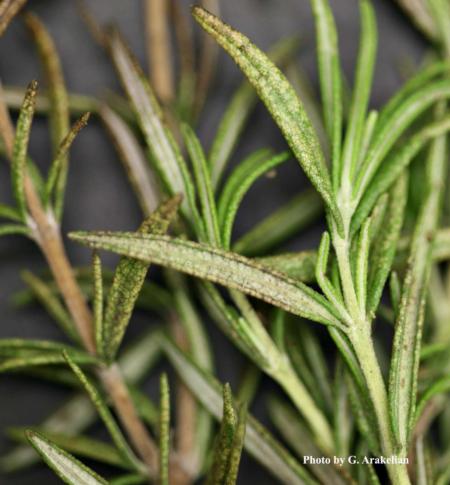INSECT HOT TOPICS: Ligurian Leafhopper
by James Bethke
Insect cast skins can be used to indicate the presence of a pest. For instance, it is pretty common for the cast skins of aphids to be observed before you actually find any live aphids. Aphids can be cryptic and sometimes on the undersides of the leaves, so it is common to see cast skins sticking to honeydew on the upper surface of the leaf below the infested leaf.
I’ll bet that if you had a shipment of plants rejected at the receivers for cast skins, you would be surprised. However, it occurred back in 2009 and again early this year. The Florida Division of Plant Industry (DPI) found cast skins on topiary rosemary plants from California at a discount store in 2008. They suspected that the insect was the Ligurian leafhopper, Eupteryx decemnotata Rey, a pest leafhopper from Europe. Back then tracebacks determined that there were populations of the Ligurian leafhopper in Napa County in Northern California and in Riverside County in Southern California, indicating that the pest was widespread in the state. This year, again, cast skins were found on topiary rosemary, but this time it was traced back to San Diego County. The San Diego County Agricultural Entomologist was able to identify the source of the infestation and help mitigate the problem.
The Ligurian leafhopper is named for its endemic range in the Ligurian Sea area of Europe, adjacent to northwest Italy. Unfortunately, it has rapidly expanded its range. Researchers attribute this spread to extensive trade and transport of catnip plants, which had become popular ornamental plants in Europe. In the mid 1990s it had spread to Portugal, Switzerland, Austria, Slovenia, Greece and much of Germany. In the late spring of 2011, huge populations of Ligurian leafhopper were found causing economic damage to sage and rosemary plants in southern England. The infestation was traced back to an importation of herb plants from Italy. Large numbers of adults were also found on sticky traps at a commercial nursery in southern England.
Ligurian leafhoppers are small (less than 3 mm long, 0.12 inches) and have colorful wing patterns (fig. 1). They possess five pairs of conspicuous spots on the head, which separates this species from close relatives. The sage leafhopper (mint leafhopper), Eupteryx melissae Curtis, is widespread in the northern United States. It has a similar wing pattern, but has fewer spots on the head.

Fig. 1. Ligurian leafhopper. Photo by G. Arakelian, Senior Biologist, Los Angeles County, Department of Agricultural Commissioner/ Weights and Measures.
Leafhoppers typically lay their eggs in stems and petioles, so they are nearly impossible to detect. This is the principle reason for the concern about the presence of so many cast skins observed in shipments from California. As with most leafhoppers, following egg hatch, leafhoppers will pass through five nymphal instars and leave cast skins just like an aphid. Cast skins of later instars look much like an infestation of live adults (fig. 2). Nymphs do not possess wings but can hop away from danger as their name suggests. If the leafhopper possesses wings, it is a full adult leafhopper.

Fig. 2. Apple leafhopper cast skins on the underside of an apple leaf. Photo by Jack Kelly Clark, courtesy of UC IPM.
Many pest leafhopper species can be detected using yellow sticky cards because flying adults are attracted to the yellow color. Leafhoppers are most commonly observed on the undersides of leaves, but they can be found on all parts of the plant, especially when in high numbers. Another method of detection is the beat and sheet method. Striking foliage or stems with your hand or stick will dislodge the leafhoppers onto a sheet or flat surface.
Ligurian leafhoppers and the sage leafhoppers are known to be pests of many popular herbs in the mint family (Lamiaceae) such as rosemary, sage, marjoram, catnip, mint and oregano. Obviously, with the ever-increasing interest in herb production, especially greenhouse herb production, there is concern about pests that may be difficult to control using organic pesticides.
Leafhoppers have piercing-sucking mouthparts and can cause damage to plants by destroying chlorophyll, removing plant fluids and by introducing toxins into the plant with their saliva. Ligurian leafhopper damage can be quite severe, and is similar to other leafhoppers (fig. 3). They cause severe stippling when high populations are present, which can lead to leaf distortion and stunting. Major damage to cultivated crops has been observed in Europe.

Fig. 3. Ligurian leafhopper damage on rosemary. Photo by G. Arakelian, Senior Biologist, Los Angeles County, Department of Agricultural Commissioner/ Weights and Measures.
Do not just assume that your plants are leafhopper-free. Use appropriate monitoring methods to detect pest infestations and remain vigilant, especially if you are shipping plants out of state.
For more information about the Ligurian leafhopper, see the following web sites:
http://www.freshfromflorida.com/pi/pest-alerts/eupteryx-decemnotata.html
http://acwm.lacounty.gov/pdf/Ligurleafhop.pdf
www.tsusinvasives.org/database/sage-leafhopper.html
www.cabdirect.org/abstracts/20073053763.html
http://wwwuser.gwdg.de/~hnickel/eup_decemnotata.pdf
http://www.fera.defra.gov.uk/plants/publications/documents/plantClinicNews/junJul11Issue.pdf
James Bethke is Farm Advisor for Nurseries and Floriculture, UC Cooperative Extension San Diego County
References
Nickel H, and Holzinger WE. 2006. Rapid range expansion of Ligurian leafhopper, Eupteryx decemnotata Rey, 1891 (Hemiptera: Cicadellidae), a potential pest of garden and greenhouse herbs, in Europe. Russian Entomological Journal 15: 295-301.
Rung, A, Halbert SE, Ziesk DC, and Gill R J. 2009. A leafhopper pest of plants in the mint family, Eupteryx decemnotata Rey (Hemiptera: Auchenorrhyncha: Cicadellidae), Ligurian leafhopper, new to North America. Insecta Mundi 0088: 1-4.












